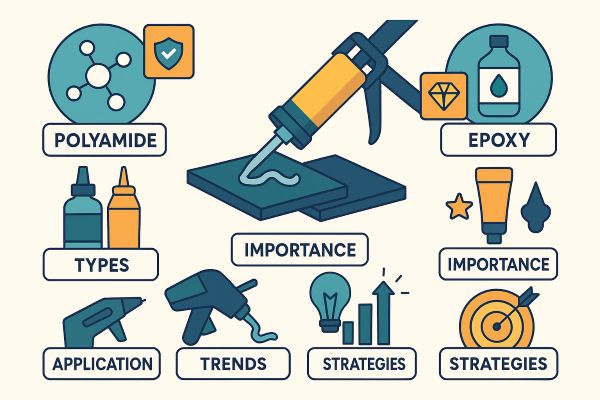
Polyamide: Definition and Properties
Epoxy: Definition and Properties
Types of Polyamide Adhesives
Types of Epoxy Adhesives
Importance of Adhesive Selection
Methods for Adhesive Application
Latest Trends in Adhesive Technology
Frequently Asked Questions (FAQ)
Polyamide is a high-performance thermoplastic polymer known for its mechanical strength, flexibility, thermal resistance, and chemical durability. These characteristics make it an ideal candidate for adhesive formulations, especially in applications requiring fast processing and environmental resistance. Compared to epoxies, polyamides often offer faster setting times and better flexibility, making them particularly suited for textiles, plastics, and lightweight assemblies.
Epoxy adhesives are formed through the reaction of epoxy resins and hardeners, resulting in a rigid, durable thermoset polymer. Known for their outstanding bonding strength, chemical resistance, and structural integrity, epoxies are favored in applications involving metals, ceramics, composites, and other high-stress materials. They typically offer superior load-bearing capacity and environmental resistance compared to thermoplastic adhesives like polyamides.
Polyamide adhesives are available in various forms, tailored for different use cases:
Hot melt polyamides: These offer fast-setting and strong bonding, especially on porous or flexible substrates like textiles, filters, or packaging materials.
high-performance polyamides: Designed for applications requiring increased resistance to heat or chemicals, offering better structural performance.
Flexible bonding polyamides: Used where elasticity and shock absorption are required.
These options allow polyamide adhesives to be applied across multiple industries, from consumer goods to industrial manufacturing.
Epoxy adhesives come in many formulations to suit a wide range of needs:
General-purpose epoxies: Suitable for household repairs and crafts, offering ease of use and decent strength.
Metal bonding epoxies: Specifically formulated for high-shear strength and thermal endurance.
Fast-curing epoxies: Designed for time-sensitive repairs and assembly operations.
High-strength industrial epoxies: Used in construction, automotive, aerospace, and marine applications for structural bonding.
Each type serves a distinct role based on material compatibility, stress conditions, and environmental exposure.
Selecting the appropriate adhesive can significantly affect product reliability and performance. For projects that require flexibility, quick handling, or bonding with plastics and textiles, polyamide adhesives are often preferred. Conversely, when strength, permanence, or environmental resistance are critical—such as in structural or metallic assemblies—epoxies offer clear advantages. Understanding the operating conditions, material types, and required curing times will help determine the right adhesive choice for each application.
Adhesive application techniques vary based on the adhesive type and the intended use:
Polyamide adhesives: Typically applied as hot melts using glue guns, slot dies, or spray systems. These methods ensure fast setting and uniform coverage, ideal for high-throughput manufacturing.
Epoxy adhesives: Require precise mixing of resin and hardener before application. Methods include manual dispensing, automated mixing systems, or dual-cartridge setups for consistent ratios.
Proper surface preparation, such as cleaning and degreasing, is essential for both adhesive types to achieve optimal bond strength and longevity.
Recent developments in adhesive technology focus on improving efficiency, sustainability, and performance:
Polyamide adhesives are evolving with improved heat resistance, bio-based content, and greater compatibility with automation equipment.
Epoxy formulations now offer faster curing times, enhanced flexibility, and hybrid properties (e.g., conductive or flame-retardant characteristics).
Both categories are being developed with reduced VOC emissions and improved recyclability to meet environmental regulations.
These trends enable manufacturers to optimize bonding processes while meeting modern performance and sustainability requirements.
What are the main properties of polyamide adhesives?
Polyamide adhesives are known for mechanical strength, thermal resistance, flexibility, and fast setting time—ideal for textiles, plastics, and light-duty structural bonding.
How do epoxy adhesives compare to polyamides?
Epoxies generally provide superior bonding strength, chemical and thermal resistance, and rigidity, making them more suitable for heavy-duty or high-stress applications.
What types of polyamide adhesives exist?
Polyamide adhesives include hot melts for rapid bonding and for high-temperature use, and flexible grades for impact resistance and elasticity.
What are the main types of epoxy adhesives?
Epoxies range from general-purpose to industrial-grade formulations, including fast-curing, high-strength, and material-specific adhesives for metals or composites.
Why is adhesive selection important?
Choosing the correct adhesive affects durability, strength, and reliability of bonded assemblies. It ensures the product performs well under specific environmental and mechanical conditions.
What application methods are used for each adhesive type?
Polyamides are applied hot using glue guns or coating systems, while epoxies require resin-hardener mixing and are applied via manual or automated dispensers.
What are the latest innovations in this field?
Innovations include faster-curing epoxies, eco-friendly polyamide formulations, and hybrid adhesives offering multi-functional properties like conductivity or thermal insulation.
When should I choose polyamide over epoxy?
Polyamide adhesives are ideal when fast setting, flexibility, or compatibility with soft materials is required. Epoxy is preferred for high-stress, structural, or chemical-exposed environments.